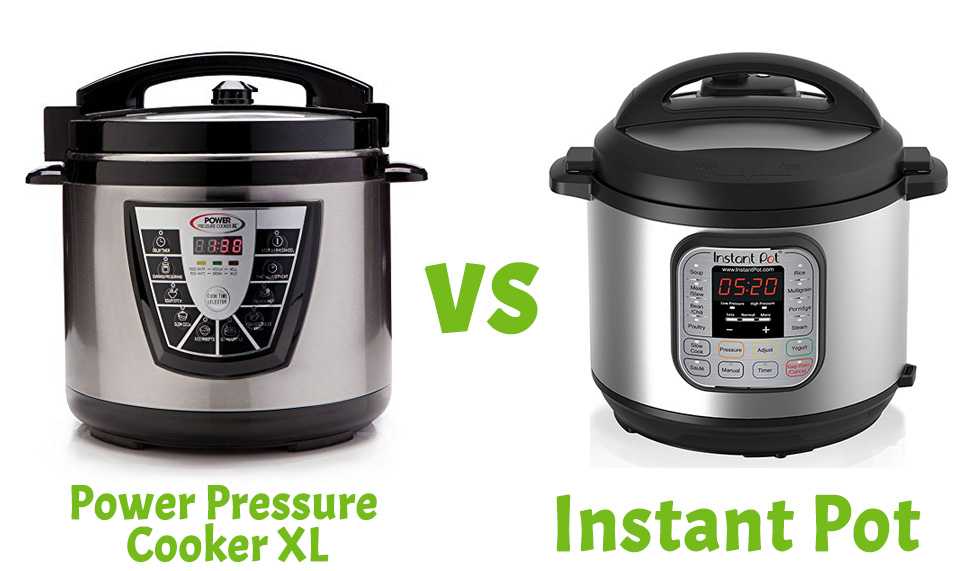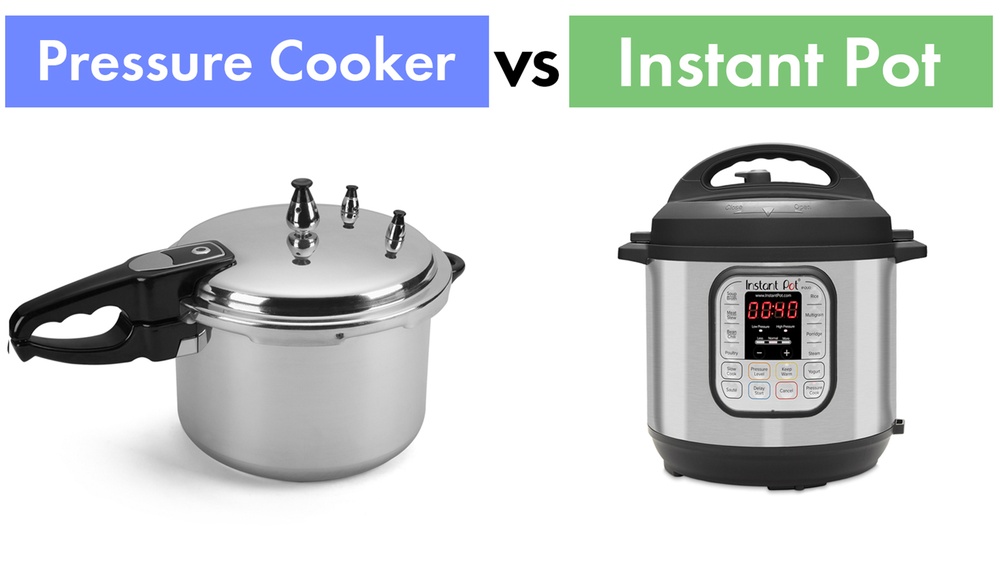Are you confused about whether to choose a pressure cooker or an Instant Pot for your kitchen? You’re not alone.
Both appliances promise faster cooking and delicious meals, but they work in different ways and offer unique benefits. Understanding these differences can save you time, money, and frustration. Keep reading to discover which one fits your cooking style and how to get the most out of your kitchen tools.
Your next meal could be easier and tastier than you ever imagined!

Credit: www.butteredveg.com
Pressure Cooker Basics
Pressure cookers are kitchen tools that cook food fast. They use steam and high pressure to reduce cooking time. This method saves energy and keeps food flavors strong. Understanding the basics helps choose the right cooker for your needs.
How Pressure Cookers Work
Pressure cookers trap steam inside a sealed pot. The steam increases pressure and raises the boiling point of water. This higher temperature cooks food quickly. The pressure also helps break down tough ingredients like meat and beans.
Types Of Pressure Cookers
There are two main types: stovetop and electric. Stovetop cookers heat on a gas or electric burner. Electric cookers have built-in heating elements and controls. Each type has benefits depending on your cooking style and kitchen setup.
Common Uses
Pressure cookers make stews, soups, rice, and beans fast. They also cook tough cuts of meat tender. Many use them for canning vegetables and fruits. These cookers help prepare meals in less time than traditional methods.
Instant Pot Features
The Instant Pot offers many features that set it apart from a traditional pressure cooker. It combines several kitchen appliances into one device. This makes cooking faster and easier.
Its advanced technology provides precise control over cooking times and temperatures. The Instant Pot is designed for convenience and safety. It allows users to prepare a variety of meals with little effort.
Multi-functionality
The Instant Pot works as a pressure cooker, slow cooker, rice cooker, steamer, and more. It can also sauté, warm food, and even make yogurt. This single appliance replaces many kitchen tools. It saves space and reduces clutter in the kitchen.
Digital Controls
The digital panel shows clear cooking options and timers. Users can choose settings with the touch of a button. It offers preset programs for different foods. This helps cook meals perfectly every time. The digital display also shows progress and alerts.
Safety Mechanisms
Instant Pot includes many safety features. It has a lid lock to prevent opening while under pressure. Sensors monitor pressure and temperature constantly. The device automatically adjusts to avoid overheating. These features protect users from accidents. Safety is a top priority in its design.
Cooking Performance
Cooking performance is a key factor when choosing between a pressure cooker and an Instant Pot. Both tools use pressure to cook food faster than traditional methods. Yet, their performance varies in speed, results, and recipe options. Understanding these differences helps you pick the right device for your kitchen needs.
Speed And Efficiency
Pressure cookers reach high pressure quickly, cooking food fast. They use direct heat from the stove, which heats rapidly. Instant Pots take a bit longer to build pressure. Electric heating means slower warm-up but steady cooking. Instant Pots save time by combining cooking steps. For example, they can sauté and pressure cook in one pot. Pressure cookers need extra pots for these steps. Instant Pots run on electricity and keep heat steady. Pressure cookers rely on stove heat, which can vary.
Cooking Results
Pressure cookers cook food evenly and keep flavors strong. They maintain high heat and pressure throughout cooking. Instant Pots also cook evenly but use controlled heat cycles. This helps avoid overcooking delicate foods. Both devices soften tough ingredients like meat and beans well. Instant Pots offer a “keep warm” feature after cooking. Pressure cookers need manual heat control to avoid cooling. The texture of food from both is usually tender and moist.
Recipe Flexibility
Pressure cookers focus mainly on pressure cooking. They require separate steps for browning or steaming. Instant Pots include multiple cooking modes. You can pressure cook, slow cook, steam, sauté, and more. This makes Instant Pots more versatile for varied recipes. Pressure cookers are simpler but less flexible. Instant Pots can handle desserts, yogurt, and rice dishes easily. Pressure cookers are best for traditional pressure cooking recipes. Instant Pots suit cooks who want one pot for many dishes.
Ease Of Use
Ease of use plays a big role in choosing between a pressure cooker and an Instant Pot. Both tools save time in the kitchen but differ in how simple they are to use. Understanding their setup, operation, and cleaning helps make a better choice.
Setup And Operation
Pressure cookers have a basic design. You place ingredients inside, seal the lid, and set the heat on the stove. You watch the pressure and adjust heat manually. It needs more attention during cooking.
Instant Pots have digital controls. You select the cooking mode with buttons. The pot adjusts time and pressure automatically. It shows clear instructions on a screen. This makes cooking easier for beginners.
Cleaning And Maintenance
Pressure cookers have fewer parts. You clean the pot and lid by hand. Some parts need careful washing to avoid damage. Regular checks for the sealing ring and valve are needed.
Instant Pots have removable inner pots that are dishwasher safe. The lid and accessories can also be washed easily. Some parts need regular inspection to keep the pot working well. Cleaning is simpler and faster overall.
Safety Considerations
Safety is a top concern when using pressure cookers or Instant Pots. These devices work under high pressure and heat. Understanding their safety features helps prevent accidents. Both tools have ways to release pressure safely. They also include features to protect users during cooking.
Pressure Release Methods
Pressure cookers usually have a manual pressure release valve. You must turn or lift it to let steam out. This method requires caution to avoid burns from hot steam.
Instant Pots offer multiple pressure release options. You can choose a natural release or quick release. Natural release lets steam out slowly. Quick release releases steam fast but needs care to avoid steam burns.
Built-in Safety Features
Traditional pressure cookers have safety locks that stop opening under pressure. They also have pressure indicators to show when it is safe to open.
Instant Pots come with more safety features. They include sensors to monitor temperature and pressure. These sensors adjust heat automatically. Instant Pots also have automatic shut-off to prevent overheating.

Credit: eatathomecooks.com
Cost And Value
Cost and value are important factors when choosing between a pressure cooker and an Instant Pot. Both tools save time in the kitchen but differ in price and features. Understanding these differences helps you make a smart purchase that fits your needs and budget.
Initial Investment
A basic pressure cooker usually costs less than an Instant Pot. Pressure cookers are simple devices with fewer parts. Instant Pots include digital controls and multiple cooking functions, which increase the price. The price of an Instant Pot can be two to three times higher than a pressure cooker. The higher cost reflects added features and convenience.
Long-term Benefits
Pressure cookers are durable and last many years with proper care. They perform one main function—pressure cooking—which is efficient and fast. Instant Pots offer versatility, replacing several kitchen appliances. They save space and reduce the need for extra gadgets. Over time, an Instant Pot may save money by handling more cooking tasks. Both tools help save energy and reduce cooking time, adding value to your kitchen.
Which One Fits Your Kitchen?
Choosing between a pressure cooker and an Instant Pot depends on your kitchen needs. Both help cook food faster and save time. Yet, each fits differently in your daily life and cooking style. Understanding your habits and space helps pick the right one.
Lifestyle And Cooking Habits
Pressure cookers work well for simple recipes and fast meals. They need more attention during cooking. Instant Pots offer many cooking modes like slow cook and yogurt making. They suit those who enjoy varied cooking styles and want convenience.
People who cook often and try new recipes may like Instant Pots. Those who want fast, no-fuss cooking might prefer pressure cookers.
Space And Storage
Pressure cookers are usually smaller and lighter. They fit easily in small kitchens or cupboards. Instant Pots are bigger and need more counter space. They stay out for quick access.
Think about your kitchen size. If space is tight, a pressure cooker saves room. If you have more space, Instant Pot offers extra features.
Budget And Priorities
Pressure cookers cost less and have fewer parts. They last long with simple use. Instant Pots are pricier due to smart features. They combine several appliances in one device.
Choose a pressure cooker for saving money and simplicity. Choose an Instant Pot if you want more functions and don’t mind spending more.

Credit: www.corriecooks.com
Frequently Asked Questions
What Is The Main Difference Between Pressure Cooker And Instant Pot?
A pressure cooker uses steam pressure to cook food fast. An Instant Pot is an electric pressure cooker with multiple cooking functions. It combines pressure cooking with slow cooking, rice cooking, and more for versatile use.
Are Instant Pots Safer Than Traditional Pressure Cookers?
Yes, Instant Pots have built-in safety features like automatic pressure control. Traditional pressure cookers require manual monitoring and can be riskier if not used properly. Instant Pots reduce the chance of accidents.
Can An Instant Pot Replace A Pressure Cooker?
Yes, an Instant Pot can replace a pressure cooker. It offers pressure cooking plus additional functions like slow cooking and yogurt making. It’s more versatile and convenient for modern kitchens.
Which Cooks Food Faster: Pressure Cooker Or Instant Pot?
Both cook food quickly using high pressure. Traditional stovetop pressure cookers often reach pressure faster. Instant Pots may take extra time to build pressure but offer consistent results and programmable settings.
Conclusion
Pressure cookers and Instant Pots both save time in the kitchen. Pressure cookers work with steam and heat to cook food fast. Instant Pots add features like slow cooking and yogurt making. Each has its own benefits depending on your cooking needs.
Choose a pressure cooker for simple, quick meals. Pick an Instant Pot if you want more cooking options. Both tools help you prepare food easier and faster. Understanding their differences makes cooking less stressful. Try each to see which suits your style best.

